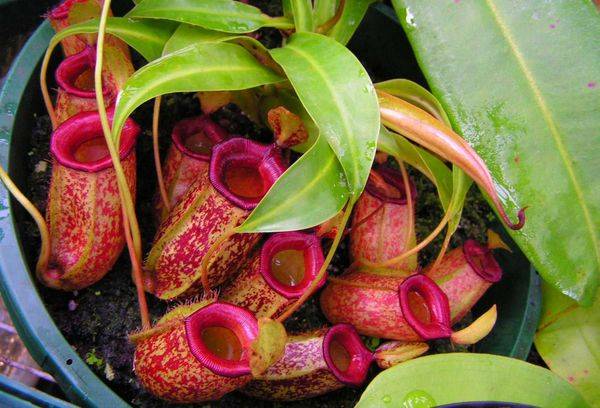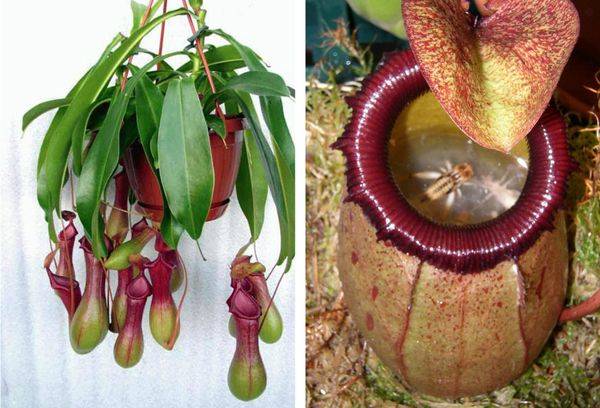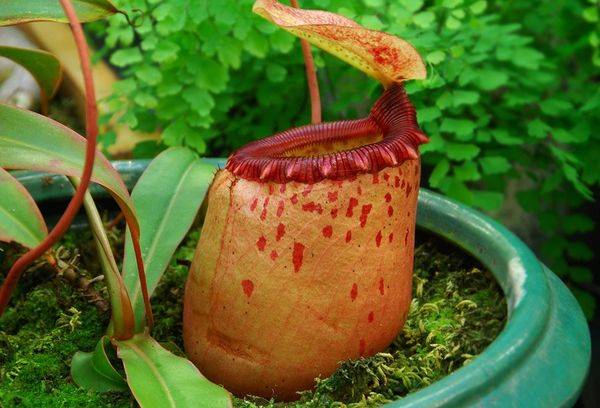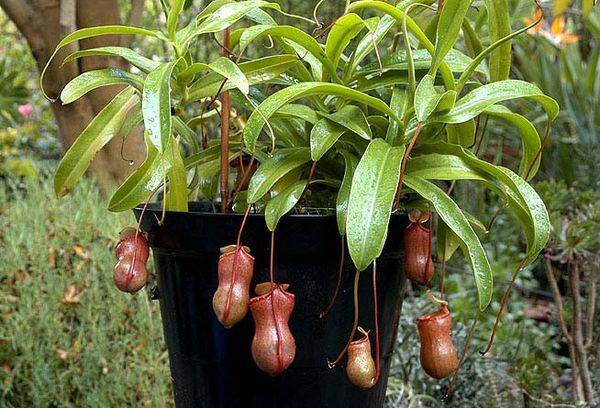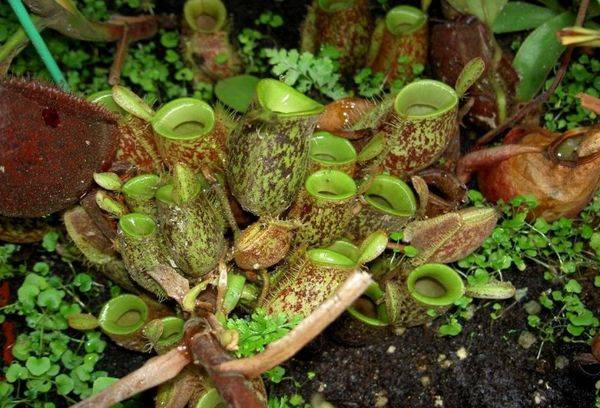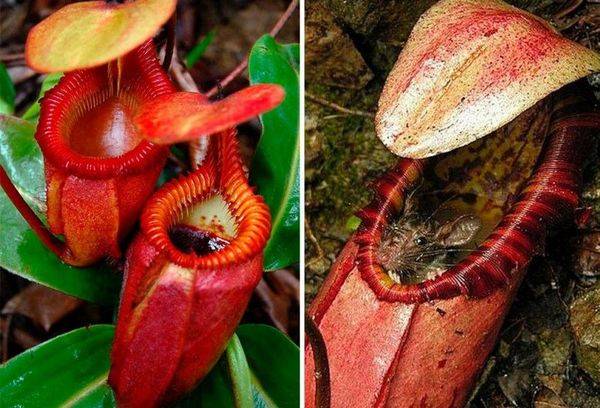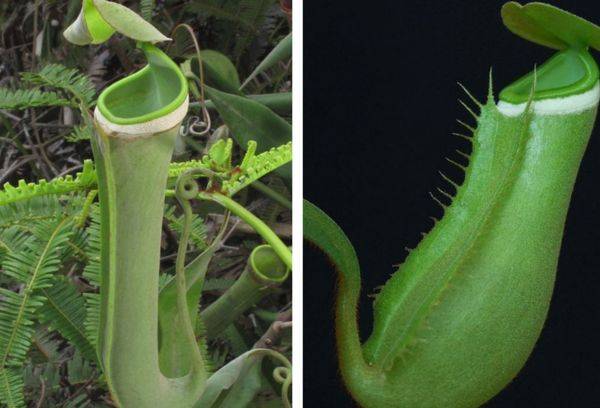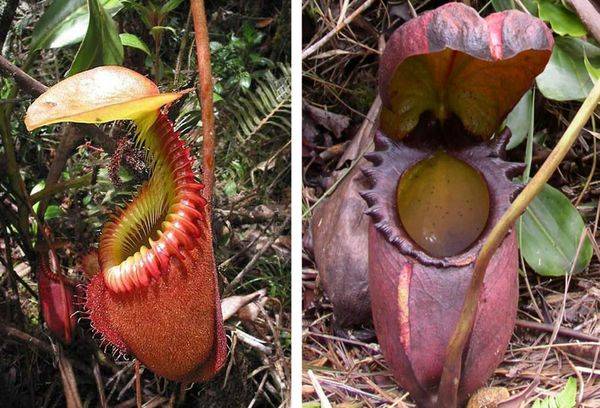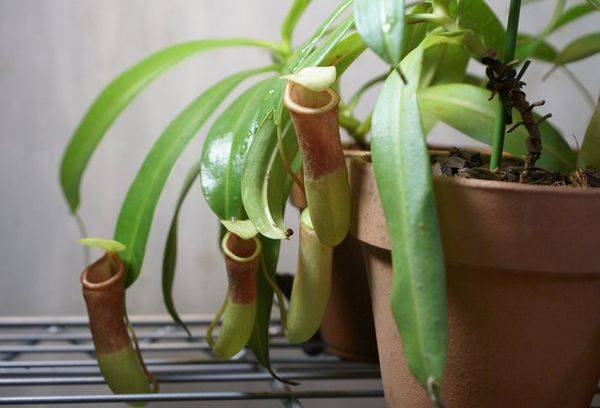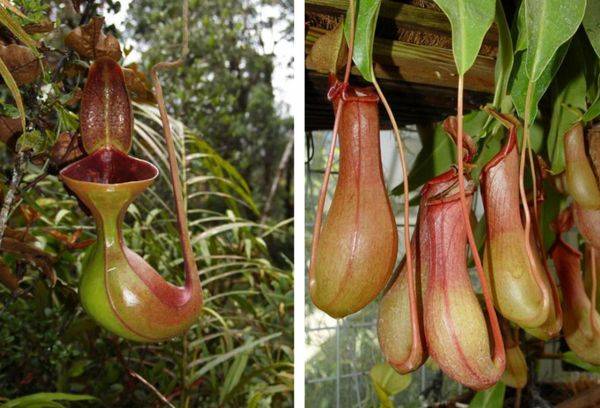Pitcherman, or Nepentes: how to care for an exotic pet
Content:
If you decide to grow Nepentes, you will have to work hard to provide him with full care. At home, it is rarely grown. This plant is not some bush of dubious origin, but a real wonder from tropical Asia. Nepentes is a predator of the plant world. Its decorative value is represented by its "water lilies", traps for insects.
About the plant
Nepenthes (Nepenthes), or pitcher - a representative of the monotypic family of non-Pentes. Basically, the plant is common in the Asian tropics, found in Madagascar, Australia and New Guinea, the Philippines, Sumatra. The flower got its name thanks to Greek mythology: Nepenfa - that is how the grass of oblivion among the Greeks was called.
Nepentes is a shrubby vine. Clinging aerial roots to trunks and thick branches of trees, it can climb quite high in search of solar energy. However, Nepentes is not a parasite.
Interesting fact
Those types of plants that attach to their higher counterparts, but do not feed on them, are called epiphytes.
The plant has two types of leaves: the first is ordinary oblong, the second is folded in the shape of a jug. They are attached to ordinary leaves with the help of antennae. It is because of the appearance of leaf traps that Nepentes has a second name - a pitcher. Usualgo traps have a bright color: red, pink or raspberry. In different species, the size of the jug varies from 2.5 to 30 cm. The inflorescences of Nepentes are inconspicuous, in the form of panicles or brushes.
Along the edge of the jug stands aromatic nectar, which lures insects. There are bristles in the jug that prevent the victim from escaping. The insect that appears inside the flycatcher leaf is digested with a special liquid (nepentesin), and only the chitinous shell remains from it.
Not only an insect, but also a small bird or rodent can become prey of Nepentes. On top of the leaf-jug is covered with a hat so that debris does not fall inside. Nepentes collaborates with some animals. For example, a flower allows bats to sleep inside pitchers, for which animals fertilize the plant with their high-nitrogen excrement.
Kinds
In the wild, there are about 70 species of water lily and about the same number of hybrids. They are divided into groups according to the height of their habitat: there are Nepentes growing in the mountains, there are lovers of the plains, and there are also connoisseurs of the “golden mean”. Some species comfortably exist only in tropical humidity, others tolerate dryness well, some prefer marshland. Alpine nepenthes are better suited for home cultivation.
- Nepentes winged- the most suitable type for indoor floriculture. It is not particularly demanding on humidity in the room. In height, the bush can reach 2 meters. Leaves are green, oblong, water lilies are large, with a reddish tinge.
- Nepentes Madagascar - shrub reaching 1.5 m in height. Water lily leaves are large (up to 25 cm), reddish-crimson. This species is better suited for greenhouses.
- Nepentes Pervilla - the leader in the diameter of water lilies. They are distinguished by a bright red color.
- Nepentes Duplexon the contrary, it has the smallest water lilies - no more than 10 cm in diameter.
- Nepentes white-fringed. This species is characterized by the most delicate color of traps - from cream to pink.
Conditions of detention
With proper care, the nepentes plant can exist at home for up to 5 years. First of all, deal with the placement of flowerpots. It is better to hang a container with a flower high so that the water lilies hang freely, as in natural conditions. In this form, the decorativeness of the plant is revealed most strongly.
Under natural conditions, nepentes grows by climbing under the crowns of tall trees. This means that the lighting should be bright, but diffused. Rooms with windows facing east or west are best suited. On the south side you need a little shading, on the north - additional illumination with a lamp. The daylight hours of the plant last an average of 16 hours, so in winter you will have to use artificial light.
Nepentes does not tolerate change. Plant pots are not recommended to be rearranged. If this is done, then the flower will stop growing, and you will have to wait at least 2 months until the plant gets used to the new conditions and starts to grow pitchers again. Also make sure that the plant does not fall under a draft. Although Nepentes loves fresh air, you need to place it away from air currents.
The soil for the flower should contain peat and sand. Special mixtures for epiphytes are recommended, and soil for orchids is also suitable. To independently prepare the soil for Nepentes, take sheet earth, peat and sand in the proportions 3: 2: 1. Sometimes sphagnum moss and charcoal are added to the substrate.
Tip
The plant does not like acidity, so only peat cannot be used.
How to care
Indoor Nepentes prefers heat and humidity. Depending on the species, the temperature of the content should vary:
- for residents of lowlands and marshes, the optimum temperature does not fall below + 16⁰ C in winter and is not understood above + 26⁰ in summer;
- the inhabitants of the highlands are suitable temperature + 20⁰ in the summer and + 12-15⁰ C in the winter.
The soil must be constantly moistened. The water temperature for irrigation is 1-2 degrees above room temperature. purityis.decorexpro.com/en/ magazine recommends pouring rain, melt or distilled water on Nepentes, and bottled drinking is also suitable. The frequency of watering in the warm season is twice a week, strictly after the topsoil has dried. In winter, the flower is watered on the second day after the earth dries.
In the natural environment, Nepentes is used to high humidity and fog. To recreate the necessary conditions, you need to periodically spray the space around the plant, for example, by installing a special humidifier. If the air is not humid enough, pitchers and ordinary leaves will die.
How to feed the plant, given its features? It is recommended to give him live insects 2-3 times a month. Some varieties well perceive standard complementary foods. Fertilizers are used for orchids or ordinary flower, but their dosage should be reduced by 3-5 times. Top dressing is applied during the growing season once every 3 weeks. Instead of root application, it is better to use leaf, that is, to spray a flower from a small spray.
Reproduction and transplantation
Nepentes propagates both by seeds and by cuttings. Cutting is carried out as follows:
- Choose a stalk from the top of the shoot or an overgrown stem.
- Cut the leaflet lower with a sharp knife or blade (they must first be disinfected).
- The shank must have at least three leaf plates. They need to be cut in half.
- Place the stalk for half an hour in a solution that stimulates growth.
- Wrap a cut of a shank with sphagnum moss and secure with a thread. Place the seedling in the prepared pot.
- It is allowed to immediately plant the stalk in the ground, deepening it by 0.5 cm.
- A container with a seedling is covered with polyethylene and hidden from direct sunlight.
- It is necessary to constantly maintain high humidity by spraying the stalk, as well as high temperature up to + 30⁰.
- 10 days after planting, it will become clear whether the plant has taken root.Its leaves should not lose brightness, on some jugs begin to form.
- Two weeks after planting, spray nepentes with a growth stimulator (2-3 drops per glass of clean water).
- Rooting takes no longer than a month and a half.
- The time for cuttings is late February or early March.
- Do not move or rotate the Nepentes pot.
- The transplantation of young Nepentes is performed no earlier than a year later.
Used reproduction and seed method. Nepentes seeds should be fresh. They are planted in a mixture of moss and sand, maintained at a temperature of + 20-25⁰ C and constantly sprayed. Seed germination is sometimes delayed up to 2 months. If young shoots appear, they are carefully transplanted into a mixture of leafy earth, sphagnum and sand.
Resettlement of an adult plant is carried out in case of emergency. If nepentes has jugs, and the roots are placed in a pot, then it is better not to disturb him. A new transplant pot is taken a little more than the previous one. The plant is moved to fresh soil without shaking off the old substrate from the roots so as not to damage the root system.
Diseases, pests, growing problems
Nepentes rarely gets sick, but there are cases of damage to the plant aphids and mealybugs. How to determine what aphids parasitize on a plant: leaves are covered with bloom and yellow spots, there is no flowering. Against aphids, rubbing the leaves with a solution of laundry soap helps: 20 g per 1 liter of water.
If the plant was attacked by a mealybug, then it slows down in development. It is necessary to dry the substrate and roots, since the worm loves increased soil moisture. Prevention will be the removal of dry leaves, wiping of leaf plates and compliance with all growing conditions.
Infrequently, but nevertheless the leaves of Nepentes are affected by chlorosis. An ailment signals a lack of iron or an abundance of peat in the substrate. With a lack of light, the flower stretches and deforms. If jugs dry, then it is necessary to increase air humidity. And excess moisture and fertilizers in the soil lead to decay of the leaves.
This is the basic information for caring for your Pentes. As you can see, to recreate the natural habitat of this plant at home is difficult, but quite real. If you are not afraid of predator plants, then Nepentes will be a worthy decoration of a collection of indoor flowers.
